20 Types of Blue Flowers That Add a Pop of Color to Your Yard
Add this rare flower color to your garden with expert-recommended plants that bloom in various shades of blue.
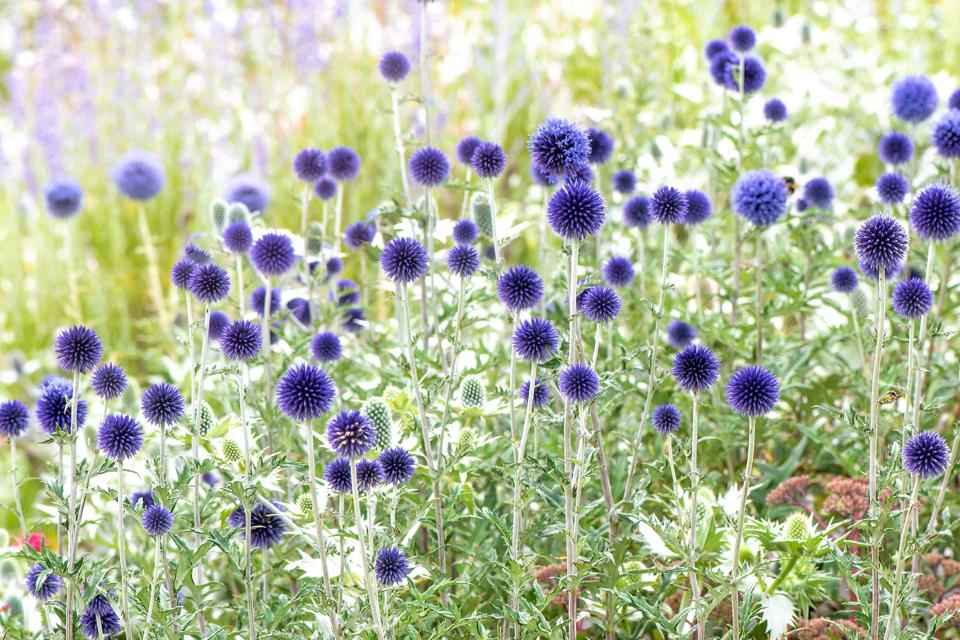
Jackie Parker Photography
Blooms come in a variety of hues, but in the flower world, blue is a rare shade. Plants can’t create blue pigments, which is why blue flowers can be hard to find. If you’re looking for a soothing indigo or nice sapphire blue blossom to try in the garden, look no further. We chatted with an expert gardener to round up all the most beautiful blue flowers to add a pop of color to your garden.
Meet the Expert
Carissa Kasper, a gardener at Seed & Nourish, where she creates and cares for kitchen gardens and their cultivators.
Lobelia
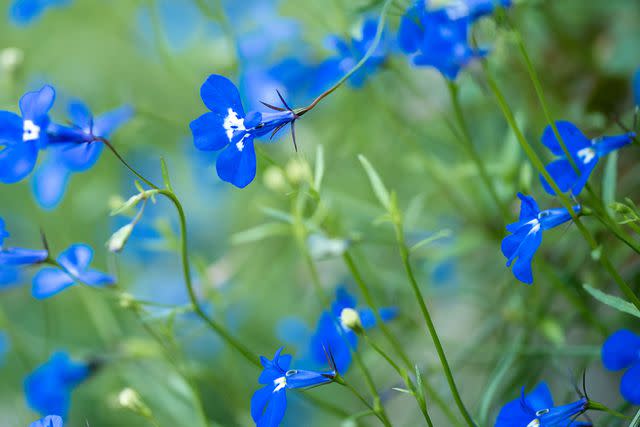
Irina Chayko / Getty Images
Lobelia (Lobelia erinus) is grown as an annual flower in many climates. It comes in a true sky blue, but can grow pink, red, purple, and white flowers. In the garden, it tends to sprawl out. "It works great in containers as a spiller to enliven an arrangement with masses of dainty flowers," says Carissa Kasper, gardener at Seed and Nourish. She recommends two rich blue varieties, Crystal Palace and Regatta Sky Blue.
Zones: 10 to 11
Mature size: 6 to 9 inches tall x 9 to 10 inches wide
Care requirements: Full sun to partial shade; moist but well-drained soil
Delphinium
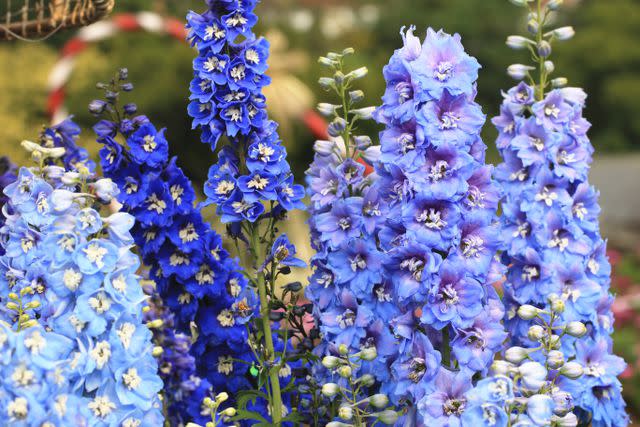
Talk about big bold blues. Delphinium (Delphinium) comes in towering columns of blue flowers. Kaspeer recommends the variety Kestrel or a sky-blue shade like Langdon’s Pandora. "Flowers bloom from late spring through summer, making fantastic thrillers in your container arrangements or a cottage garden," says Kasper.
Zones: to 9
Mature size: 6 inches to 7 feet tall
Care Requirements: Full sun to partial shade; loam, well-draining soil
Borage
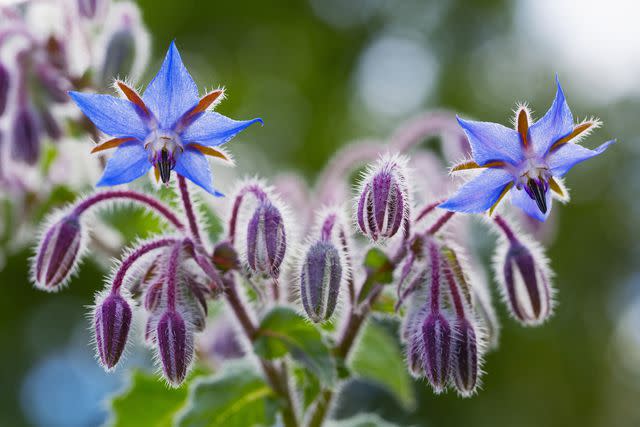
A great companion plant to many garden vegetables like strawberries, borage (Borago officinalis) has star-shaped flowers that add color and interest to a yard. "Easily grown by seed, they readily self-sow," says Kasper.
Zones: 2 to 11
Mature size: 1 to 3 feet tall x 9 to 18 inches wide
Care Requirements: Full sun to partial shade; well-draining soil
Salvia
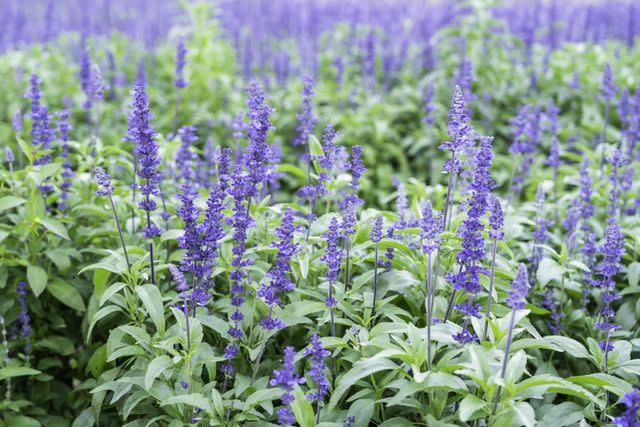
Getty Images
Salvia (Salvia sylvestris) is a pretty annual. "The Black and Bloom salvia variety produces long-lasting spikes of rich-blue flowers that are incredibly attractive in containers and the landscape alike," says Kasper.
Zones: 4 to 8
Mature size: 1 to 2 feet tall x 2 feet wide
Care Requirements: Full sun; well-draining soil
Related: 15 Colorful Flowers That Will Turn Your Yard Into an Artist's Canvas
Lupin
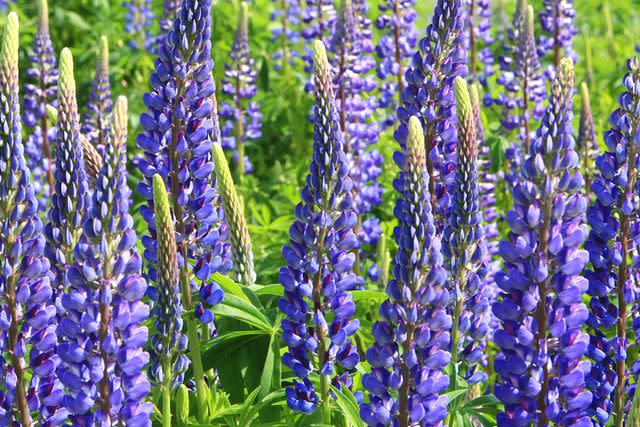
Getty Images
With the common name of bluebonnet, it’s no surprise lupine (Lupinus x hybrida) is known for its blue flowers, but it also adds nutrients to the ground. "As a member of the legume family, they can help fix nitrogen in the soil—great for soil remediation," says Kasper.
Zones: 4 to 8
Mature size: 3 to 4 feet tall x 1 to 2 feet wide
Care requirements: Full sun; moist but well-drained soil
Iris
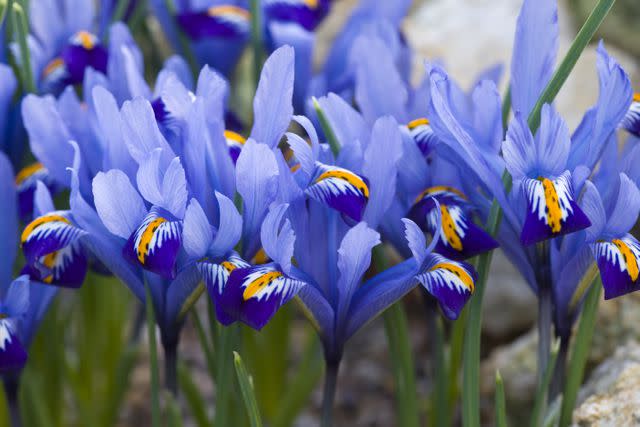
Clive Nichols / Getty Images
Iris (Iris germanica) is a large flower genus that includes a range of blue varieties. The bearded iris (Iris germanica) is the most popular because it’s so easy to grow and replants itself. "The rhizomes or bulbs spread year to year, so they are a gift that keeps giving," says Kasper.
Zones: 3 to 9
Mature size: 12 to 40 inches tall x 1 to 2 feet wide
Care requirements: Partial sun to shade; well-drained soil
Related: 11 Colorful Perennial Flowers That Will Thrive All Summer
Hydrangea
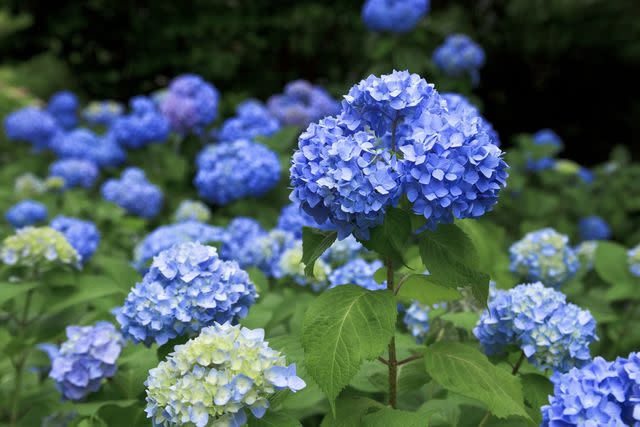
The color of a hydrangea (Hydrangea spp.) depends on its soil. "To produce blue blooms, choose Bigleaf and Mountain hydrangeas and grow them in acidic soil," says Kasper. For even more blue in your yard, pair the flowers with other acidic-loving blue plants like blueberries.
Zones: 5 to 9
Mature size: 2 to 20 feet tall x2 to 6 feet wide
Care requirements: Full to partial sun; moist but well-drained soil
Related: How to Grow and Care for Hydrangeas That Yield Big, Beautiful Blooms Every Season
Cornflower
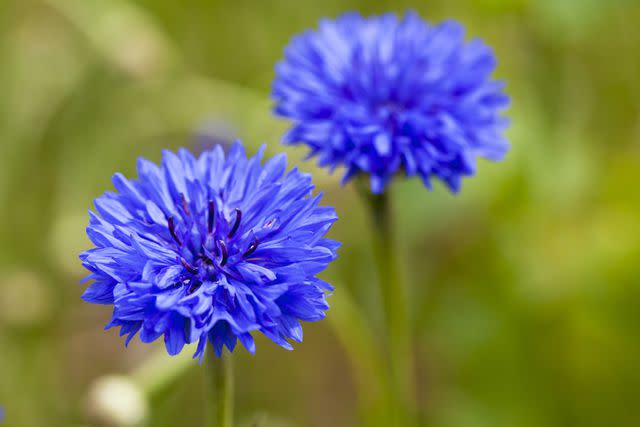
Known as Bachelor’s Button, cornflower (Centaurea cyanus) comes in many shades including blue, and is very easy to grow. "Cornflowers are quick to grow from seed making them an economic and prolific choice," says Kasper. "Take care where you plant them as they can spread easily."
Zones: 2 to 11
Mature size: 12 to 48 inches tall x 10 to 12 inches wide
Care requirements: Full to partial sun; moist but well-drained soil
Lungwort
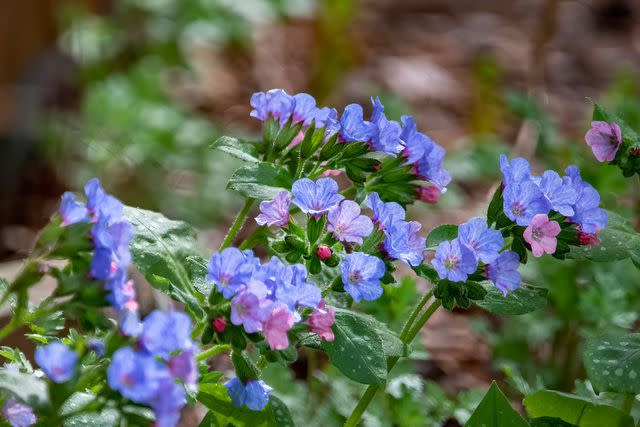
Getty Images
Lungwort (Pulmonaria spp.) flowers are bell-shaped and start out pinkish in hue until they mature, when they become violet-blue. Not only pretty, but lungwort is simple to maintain. It replants itself, as its rhizomatous roots gradually spread across a yard.
Zones: 5 to 9
Mature size: 6 to 12 inches high x 1 to 2 inches wide
Care requirements: Full sun to part shade; moist, well-drained soil
Liverleaf
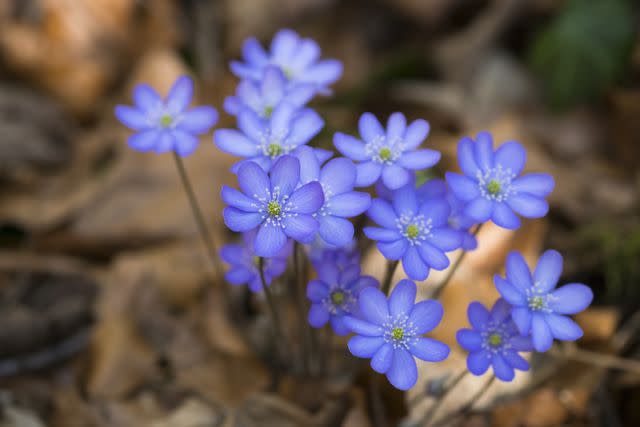
Westend61 / Getty Images
Liverleaf (Anemone americana) is a low-growing perennial with blue flowers verging on a lavender shade. In winter, the plant’s leaves go brown but will eventually turn green again in spring.
Zones: 3 to 8
mature size: 6 inches high x 9 inches wide
Care requirements: Part shade; moist, well-drained soil
Nigella
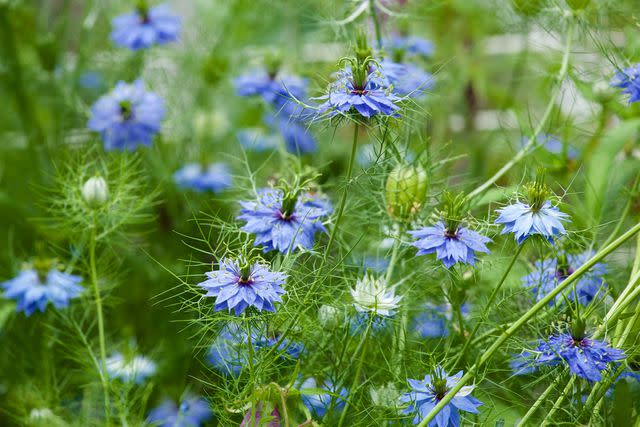
Billy_Fam / Getty Images
Due to its delicate foliage and misty blue flowers, nigella (Nigella damascena) has a common name of "love-in-a-mist." The blues come in a range of colors, adding visual interest to a cottage garden.
Zones: 2 to 11
Mature size: 8 to 20 inches tall x 3 to 6 inches wide
Care requirements: Full to partial sun; well-drained soil
Related: How to Create an English Cottage Garden Wherever You Live
Bluebeard

Getty Images
Complete with soft gray foliage and blue blooms, Bluebeard (Caryopteris × clandonensis) is a beautiful perennial flowering shrub. Its pale blue flowers are some of the few genuinely blue in the flower world.
Zones: 6 to 9
Mature size: 2 to 4 feet tall and wide
Care requirements: Full sun; moist but well-drained soil
Globe Thistle
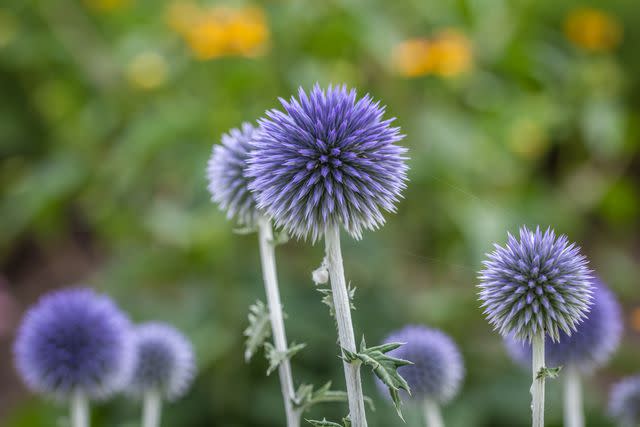
Globe thistle (Echinops spp.) has amazing blue blossoms. "These electric-blue round flowers on powdery-blue stems are almost hard to believe are real," says Kasper. The plants are also great to pop into a garden because "they’re extremely drought tolerant and easy to care for," she says.
Zones: 3 to 9
Mature size: 2 to 5 feet tall x 1 to 4 feet wide
Care requirements: Full sun; well-drained soil
False Indigo
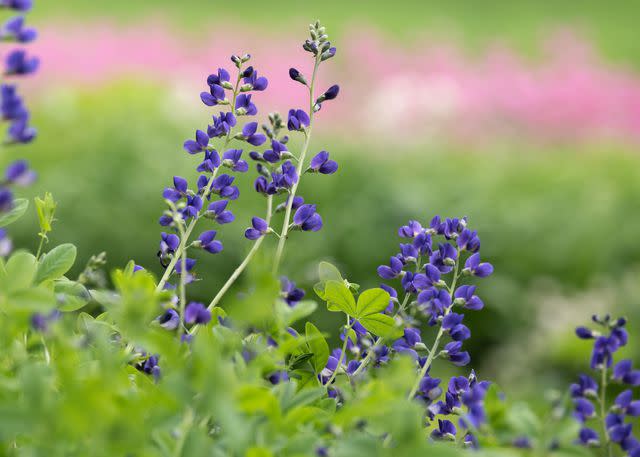
The Spruce / Evgeniya Vlasova
False indigo (Baptisia australis) is both pretty and useful for a garden. "These pollinator-attractors form spires of teardrop-shaped indigo blooms on highly attractive foliage," says Kasper. "And as a member of the legume family, it is a nitrogen-fixer."
Zones: 3 to 9
Mature size: 4 to 5 feet tall by 3 to 4 feet wide
Care requirements: Full to partial sun; moist well-drained soil
Hyacinth
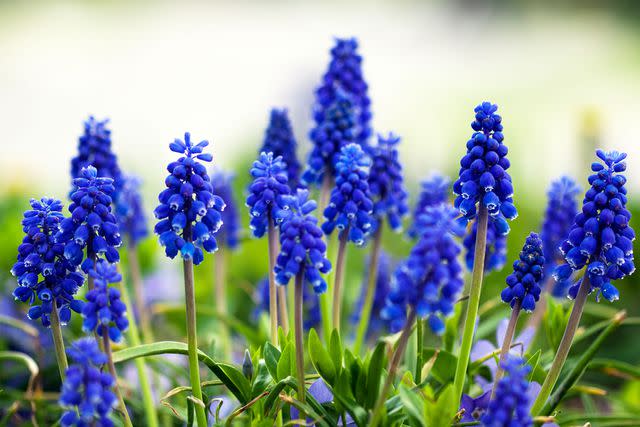
Lisa Stokes / Getty Images
Hyacinth (Hyacinthus orientalis) comes in brilliant blue in addition to other shades like white, purple, pink, and red. Hyacinths are bulb plants, so they come back every year and self-divide underground, appearing in early spring just in time for Easter.
Zones: 4 to 8
Mature size: 6 to 12 feet tall x 3 to 6 feet wide
Care requirements: Full to partial sun; moist well-drained soil
African Lilly
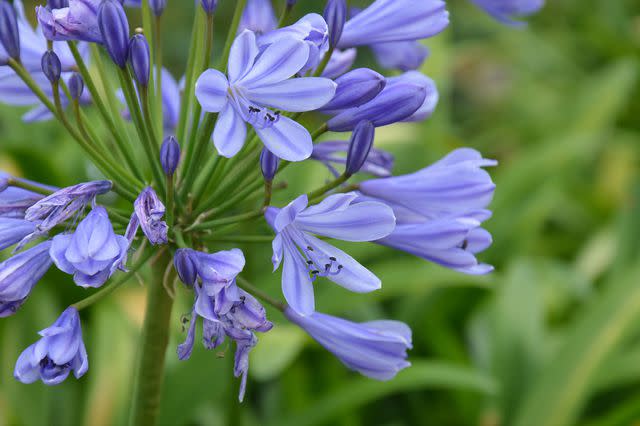
Coming in clusters of white or blue flowers, African lilly (Agapanthus) has tall stalks, adding a sense of height to your yard. They are also rabbit and deer-resistant, but still attract plenty of butterflies and other pollinators.
Zones: 7 to 10
Mature size: 3 feet tall x 2 feet wide
Care requirements: Full to partial shade; sandy well-drained soil
Related: 15 Pollinator Plants That Will Attract Birds, Bees, and Butterflies to Your Garden
Blue Star
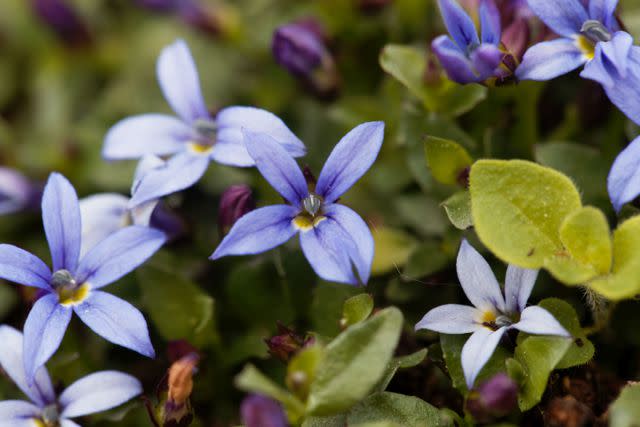
Known for its star-shaped flowers, blue star (Amsonia) is native to many regions of North America, so they are easy to grow and maintain. The flowers are small but pretty and bloom for many weeks in spring. By winter, the foliage will also put on a show, changing to yellowish gold depending on the variety.
Zones: 3-11
Size: 2 to 3 feet tall by 2 to 3 feet wide
Care Requirements: Full to partial shade; sand, chalk, clay, and loam soils
Gentians
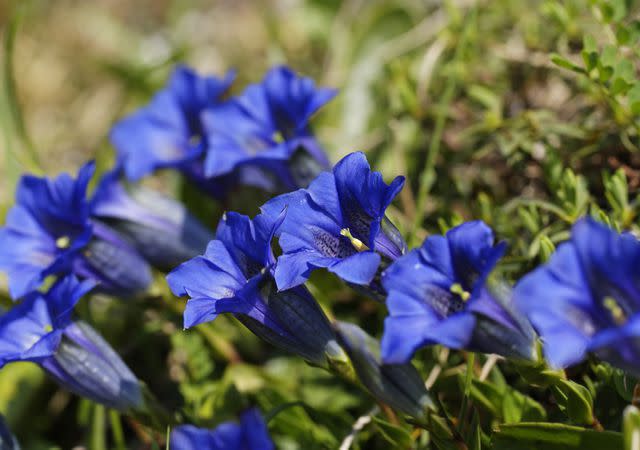
Gentians (Gentiana) are woodland plants that prefer cooler spaces. They tend to be late season blooms but spread out, covering a larger area, even if for a short time.
Zones: 4-8
Size: 1 to 3 feet tall by 6 to 12 feet wide
Care Requirements: Full sun to part shade; moist, well-drained soil
Siberian Squill
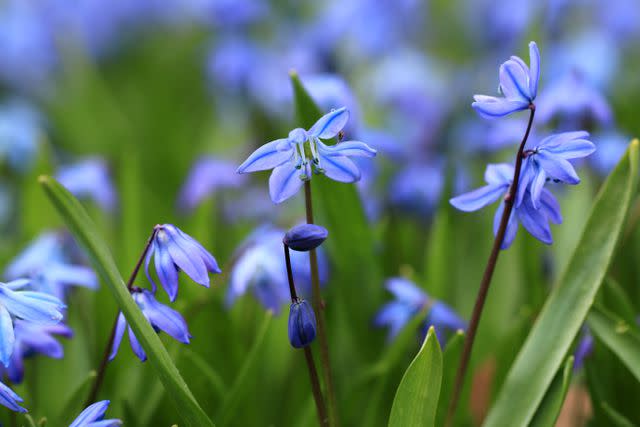
Siberian squill (Scilla siberica) lies dormant during winter but is quick to reappear in spring. As an early bloomer, not only does it usher in blue to a new spring garden but it will also be less likely to fall prey to summer pests or insects.
Zones: 2-8
Size: 6 inches tall by 2 inches wide
Care Requirements: Full sun to part shade; well-drained soil
Blue Spur
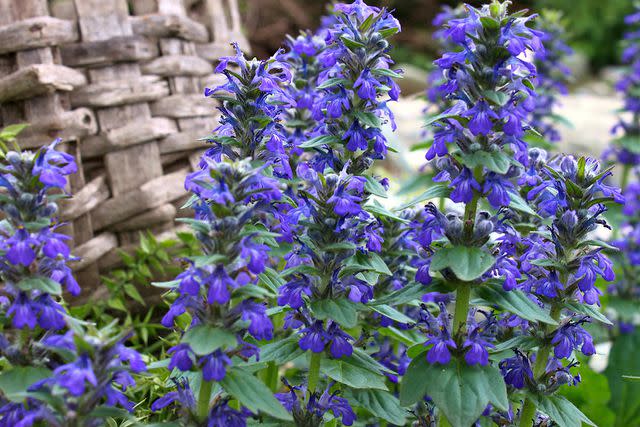
Alisa Gabliya
With blue colors verging on purple, blue spur (Plectranthus barbatus) has tall blossoms and vibrant green foliage. If it gets enough sun and is planted in the right climate, this plant is an easy addition to any garden.
Zones: 9-11
Size: 5 to 8 feet tall by 5 to 8 feet wide
Care Requirements: Full sun to partial sun; moist but well-drained soil
Read the original article on Martha Stewart.

